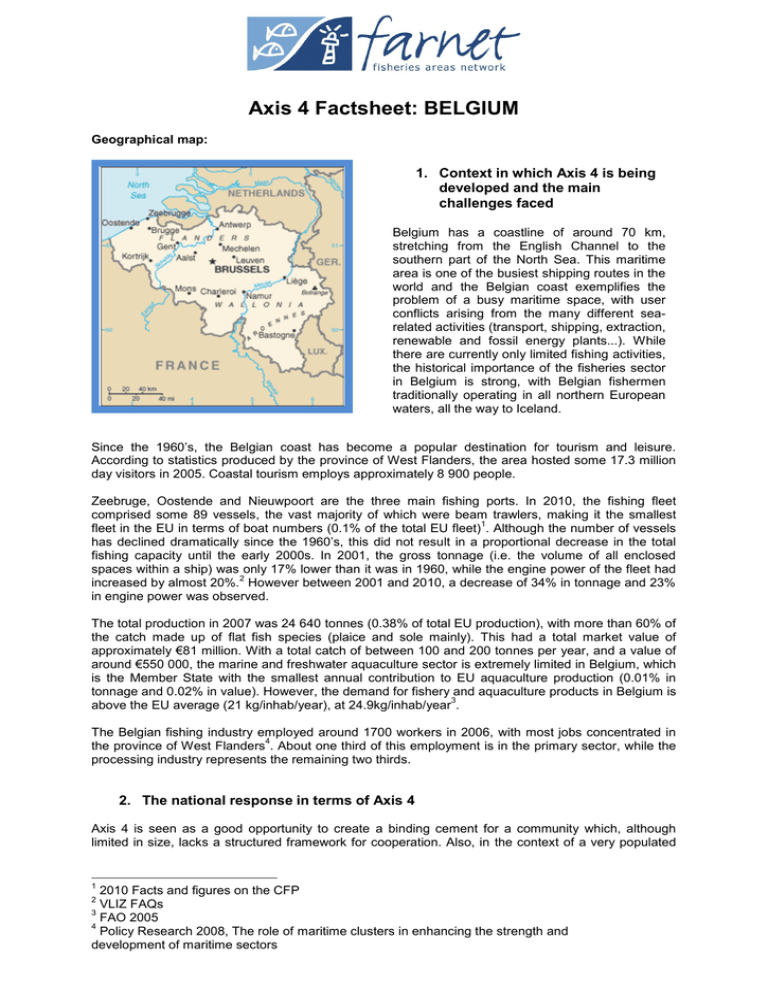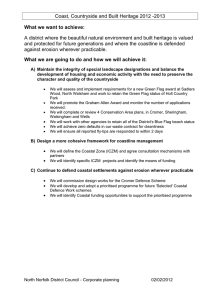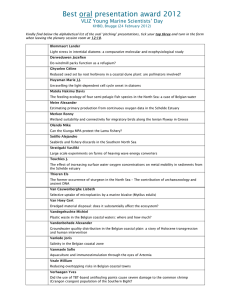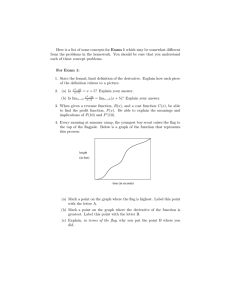Axis 4 Factsheet: BELGIUM developed and the main
advertisement

Axis 4 Factsheet: BELGIUM Geographical map: 1. Context in which Axis 4 is being developed and the main challenges faced Belgium has a coastline of around 70 km, stretching from the English Channel to the southern part of the North Sea. This maritime area is one of the busiest shipping routes in the world and the Belgian coast exemplifies the problem of a busy maritime space, with user conflicts arising from the many different searelated activities (transport, shipping, extraction, renewable and fossil energy plants...). While there are currently only limited fishing activities, the historical importance of the fisheries sector in Belgium is strong, with Belgian fishermen traditionally operating in all northern European waters, all the way to Iceland. Since the 1960’s, the Belgian coast has become a popular destination for tourism and leisure. According to statistics produced by the province of West Flanders, the area hosted some 17.3 million day visitors in 2005. Coastal tourism employs approximately 8 900 people. Zeebruge, Oostende and Nieuwpoort are the three main fishing ports. In 2010, the fishing fleet comprised some 89 vessels, the vast majority of which were beam trawlers, making it the smallest 1 fleet in the EU in terms of boat numbers (0.1% of the total EU fleet) . Although the number of vessels has declined dramatically since the 1960’s, this did not result in a proportional decrease in the total fishing capacity until the early 2000s. In 2001, the gross tonnage (i.e. the volume of all enclosed spaces within a ship) was only 17% lower than it was in 1960, while the engine power of the fleet had 2 increased by almost 20%. However between 2001 and 2010, a decrease of 34% in tonnage and 23% in engine power was observed. The total production in 2007 was 24 640 tonnes (0.38% of total EU production), with more than 60% of the catch made up of flat fish species (plaice and sole mainly). This had a total market value of approximately €81 million. With a total catch of between 100 and 200 tonnes per year, and a value of around €550 000, the marine and freshwater aquaculture sector is extremely limited in Belgium, which is the Member State with the smallest annual contribution to EU aquaculture production (0.01% in tonnage and 0.02% in value). However, the demand for fishery and aquaculture products in Belgium is 3 above the EU average (21 kg/inhab/year), at 24.9kg/inhab/year . The Belgian fishing industry employed around 1700 workers in 2006, with most jobs concentrated in 4 the province of West Flanders . About one third of this employment is in the primary sector, while the processing industry represents the remaining two thirds. 2. The national response in terms of Axis 4 Axis 4 is seen as a good opportunity to create a binding cement for a community which, although limited in size, lacks a structured framework for cooperation. Also, in the context of a very populated 1 2010 Facts and figures on the CFP VLIZ FAQs 3 FAO 2005 4 Policy Research 2008, The role of maritime clusters in enhancing the strength and development of maritime sectors 2 and urbanised coastal area, Axis 4 can help to facilitate the participation of fishermen, with other local stakeholders, in the integrated planning and use of coastal resources. 3. The areas and their key characteristics West Flanders FLAG Area (km²) 368 Population 218 599 Pop. density 594 (hab/km²) Due to the limited length of the Belgian coastline (around 70km), the entire area has been selected as eligible for Axis 4 support. The population density along the Belgian coast is one of the highest in Europe and this puts considerable pressure on the coastal environment. Coastal communes and the remaining fisheries communities face similar challenges in terms of addressing spatial planning and user conflicts in a way that ensures the coherence of the area. A Leader area borders the Axis 4 area in the districts of Veurne, Ieper and Diksmuide, and coordination with the existing LAG was considered to be an important criterion in establishing the FLAG. 4. The selection process - when and how the groups were selected Belgium launched its call for proposals before the summer 2010 and all strategies were to be submitted by the 15 October 2010. This was followed and preceded by several information sessions and workshops involving fisheries and coastal stakeholders. The province of West Flanders expressed its interest in acting as a lead entity for a Fisheries Local Action Group and facilitated several meetings with other interested parties with the aim of developing a local strategy in response to the call. This was the only application submitted for the Belgian coast and it was subsequently approved. The West Flanders FLAG was officially approved in May 2011 and launched its first call for projects in June 2011. 5. The groups - representation of main stakeholders, legal form As the local partnership approach is a new concept for the Belgian fisheries sector, it was decided to appoint one of the FLAG partners as the lead administrative and legal entity. Given its experience in the management of Leader, the province of West Flanders was duly appointed. The Province has recruited a full time FLAG manager, as well as secretarial assistance. Both are based within the Provicial Ankerpunt Kust, an existing body, responsible for implementing integrated coastal zone management (ICZM) on the Belgian coast. According to the Belgian Operational Programme for the EFF, socio economic partners should represent a minimum of 50% of the decision making body and a third of FLAG members should be composed of women. 6. The strategy The fisheries sector in Belgium is facing intense competition from alternative uses of the maritime and coastal environment. The strategy of the only Belgian FLAG focuses, therefore, on preserving and valuing the fisheries sector as an integral part of the coastal heritage, with the ultimate goal of enhancing its economic viability. 7. Key features of the administrative and financial systems % of EFF budget for Axis 4 7.23% EFF budget for Axis 4 / € 1 900 000 National funding /€ 2 528 410 Total budget / € Average budget per group / € 4 428 410 4 428 410 Number groups of 1 The FLAGs opens calls for projects; Project promoters submit their proposals to the FLAG secretariat, which can help the project promoters in the process; The submitted projects are presented to the regional fisheries administration of Flanders with a request for co-financing of 10% of the budget of the project. The fisheries administration may decide to provide the additional co-financing, depending on the relevance of the project to the OP and on its fisheries character. If sufficient co-financing is received, the project enters the selection process. If no additional co financing is provided by the regional fisheries administration, the FLAG has to find alternative additional co financing possibilities or put the project on hold; Once co financing is secured, the FLAG appoints readers for each of the project proposal. The readers, which can be members of the FLAGs or external experts recruited on an ad hoc basis, report to the FLAG steering committee. Based on the readers report, the FLAG steering committee evaluates the project, based on the FLAG selection criteria, and takes the decision to support the project or not. Decisions are taken on the basis of unanimity if possible, or otherwise through a voting system; Once the project is approved by the FLAG, it can begin the implementation process. The financial and administrative management (payment to the beneficiary, spot checks,...) of the project is handled by the Managing Authority. 8. Networking and capacity building - main features of networks, training and capacity building programmes As only one FLAG is foreseen in Belgium, there is no requirement for a network. However, the FLAG itself still plays a role at local level in the networking of coastal stakeholders. Members of the FLAG also recognise the importance of networking at international level. 9. Any resource or idea that may be of interest to other countries The capacity building and information process for local stakeholders was extensive and may provide inspiration for other areas where the fishing sector is equally marginalised at local/regional level. 10. Contacts and links Managing Authority: Ms. Sasja Debruyne VLAAMSE OVERHEID - Departement Landbouw en Visserij Afdeling Landbouw- en Visserijbeleid Koning Albert II-laan 35, bus 40 7de verdieping 1030 Brussels Tel: +32 2 552.79.38 Fax: +32 2 552.79.21 E-mail: sasja.debruyne@lv.vlaanderen.be Website: http://www.vlaanderen.be/landbouw Last update: January 2013





